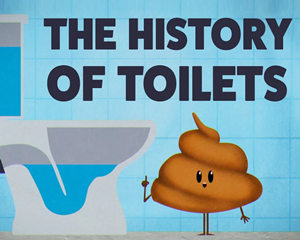On sunny days, the Roman citizens of Ostia could be found on a long stone bench near the Forum.
晴天,奥斯蒂亚的古罗马公民都会聚集在公共集会场所附近的一张长条石凳上。
Friends and neighbors exchanged news and gossip while simultaneously attending to more... urgent business.
朋友和邻居间交换新闻和八卦的同时也进行着一项更迫切的事。
These public latrines could sit up to 20 Romans at a time, draining waste in water conduits below.
这些公共厕所能通过下面的水管排掉代谢物,一次可供20名罗马公民使用。
Today, most cultures consider trips to the restroom to be a more private occasion.
如今,大多数文化认为上洗手间是一件更为私密的事情。
But even when going alone, our shared sewage infrastructure is one of the most pivotal inventions in the history of humanity.
但即便是一个人去洗手间,公共的污水基础设施是人类历史上至关重要的发明之一。
While many ancient religious texts contain instructions for keeping waste away from drinking water and campsites,
许多古代宗教文本中记载着将废水与饮用水以及野营地隔离的方法,
waste management took a more familiar shape as early as 3000 BCE.
早在公元前3000年的废水管理已具备了当代类似的形态。
Ancient Mesopotamian settlements often had clay structures made for squatting or sitting in the most private room of the house.
古老的美索不达米亚定居点在房子最私密的位置通常有粘土结构,用于蹲坐。
These were connected to pipes which used running water to move waste into street canals and cesspits.
它们与管道相连,管道中的流动水将排泄污物排入街道的水渠和污水坑中。
Water infrastructure like this flourished in the Bronze Age,
例如上述在青铜时代蓬勃发展的例子,
and in some parts of the Indus Valley, nearly every house had a toilet connected to a citywide sewage system.
以及在印度河流域的某些地区,近乎每个房子的厕所都会与城市污水系统相连。
Ancient Cretan palaces even offered a manual flushing option.
古代克里特宫殿的厕所甚至可以手动冲洗。
Researchers can't say for certain what inspired these early sewage systems, but we do know that waste management is essential for public health.
研究人员并不确定这些早期的污水设施是怎么被发明的,但能够确定的是污水管理是公共卫生的关键。
Untreated sewage is a breeding ground for dangerous microorganisms, including those that cause cholera, dysentery, and typhoid.
未经处理的污水能滋养有害微生物,从而导致霍乱、痢疾以及伤寒等疾病。
It would be several millennia before scientists fully understood the relationship between sewage and sickness.
然而污水与疾病的关系至少还需要几千年科学家们才能透彻了解。
But the noxious odors of sewage have recorded associations with disease as early as 100 BCE.
不过恶臭的污水气味与疾病的关系早在公元前100年就有所记载。
And by 100 AD, more complex sanitation solutions were emerging.
到了公元100年,更复杂的卫生解决方案问世。
The Roman Empire had continuously flowing aqueducts dedicated to carrying waste outside city walls.
罗马帝国采用持续流动的水道,将废水引至城市外围。

Chinese dynasties of the same period also had private and public toilets, except their waste was immediately recycled.
同时期的中国也有私人和公共厕所,只是在中国,这些排泄污物是被即时循环使用的。
Most household toilets fed into pig sties, and specialized excrement collectors gathered waste from public latrines to sell as fertilizer.
家用厕所的粪便大多会用于喂猪,而公共厕所的代谢物会由专门的人来收集并制成肥料卖出。
In China, this tradition of waste management continued for centuries, but in Europe the fall of the Roman Empire brought public sanitation into the Dark Ages.
中国的传统粪便污废物处理方法持续了好几个世纪,但是在欧洲,罗马帝国的衰落把公共卫生带入了黑暗时期。
Pit latrines called "gongs" became commonplace, and chamber pots were frequently dumped into the street.
坑式蹲厕(也被称作“Gong”)司空见惯,夜壶常常直接往街道上倾倒。
Castles ejected waste from tall windows into communal cesspits.
城堡的高窗向外面的公共粪池抛弃排泄污物。
At night, so-called gong farmers would load up the waste before traveling beyond city limits to dump their cargo.
到了晚上,掏粪工会把排泄污物装满推车,将它们运出城外并丢弃。
Europe's unsanitary approach persisted for centuries, but toilets themselves underwent some major changes.
几个世纪以来,欧洲都没有对排泄污物进行卫生处理,但是厕所本身却经历了一些重大变革。
By the late Middle Ages, most wealthy families had commode stools -- wooden boxes with seats and lids.
到中世纪后期,大多数富裕人家都配备了坐便器--带有盖子和座椅的木箱子。
And in the royal court of England, the commodes were controlled by the Groom of the Stool.
在英格兰的皇室宫廷中,这些座便器由专门的管理排泄污物的侍从负责。
In addition to monitoring the king's intestinal health, the Groom's intimate relationship with the monarch made him a surprisingly influential figure.
另外,为了监测国王的肠道健康,这位侍从和国王无比亲密的关系使得这个职称变得极具影响力。
The next major leap in toilet technology came in 1596, when Sir John Harrington designed the first modern flush toilet for Queen Elizabeth.
厕所科技发展史中的下一个大跃进出现在1596年:约翰·哈林顿爵士为伊丽莎白女王设计了第一个现代抽水马桶。
Its use of levers to release water and a valve to drain the bowl still inform modern designs. But Harrington's invention stank of sewage.
它利用杠杆放水并用阀门抽干桶中的水,为现代马桶设计提供了参考。但是哈林顿的发明没有解决污水臭味的问题。
Thankfully, in 1775, Scottish inventor Alexander Cumming added a bend in the drainpipe to retain water and limit odors.
幸好到了1775年,苏格兰发明家亚历山大·卡明在排水管道处加了一个弯曲的设计进行保水限臭。
This so-called S-trap was later improved into the modern U-bend by Thomas Crapper -- though the term "crap" predates the inventor by several centuries.
这个S型设计经托马斯·克拉珀改进成现代的U型设计--尽管“废物”一词比发明者出现早几个世纪。
By the turn of the 19th century, many cities had developed modern sewage infrastructure and wastewater treatment plants,
到了19世纪末,许多城市都已经有了现代污水基础设施以及污水处理厂,
and today, toilets have a wide range of features, from the luxurious to the sustainable.
如今,厕所也发展出了广泛的特征--从奢华到可持续性。
But roughly 2 billion people still don't have their own toilets at home.
然而仍有大约20亿的人在家中没有于个人使用的厕所。
And another 2.2 billion don't have facilities that properly manage their waste, putting these communities at risk of numerous diseases.
还有另外22亿人没有适当管理废水的设施,使他们被暴露在无数疾病的威胁下。
To solve this problem, we'll need to invent new sanitation technologies and address the behavioral, financial, and political issues that produce inequity throughout the sanitation pipeline.
为了解决这个问题,我们需要发明新的卫生技术,并解决会造成卫生管道系统不公平的行为、经济以及政治方面的诸多问题。


